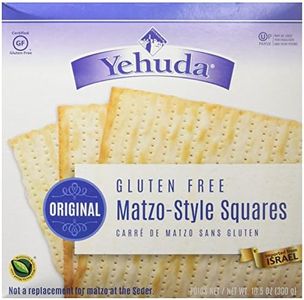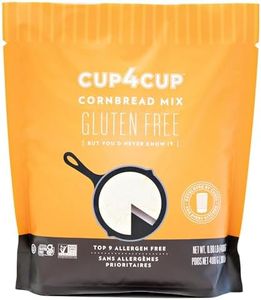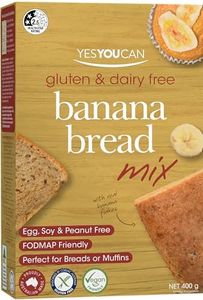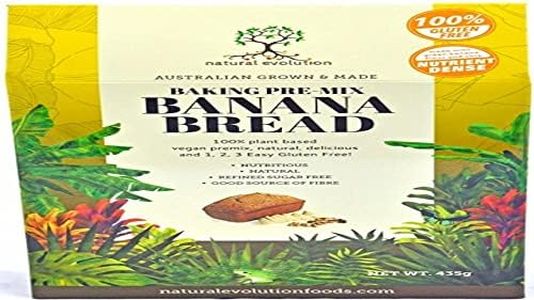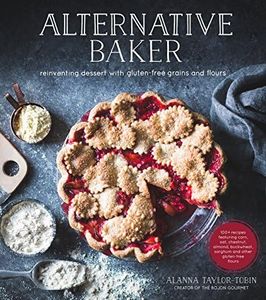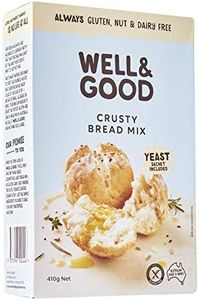We Use CookiesWe use cookies to enhance the security, performance,
functionality and for analytical and promotional activities. By continuing to browse this site you
are agreeing to our privacy policy
7 Best Gluten Free Breads
From leading brands and best sellers available on the web.By clicking on a link to a third party's website, log data is shared with that third party.
Buying Guide for the Best Gluten Free Breads
Choosing a gluten-free bread requires a bit of awareness, since this category is meant for people who have celiac disease, gluten sensitivity, or who simply want to avoid gluten in their diet. Gluten-free breads are made without wheat, barley, or rye and use alternative grains and binders. Not all gluten-free breads are created equal—differences in texture, taste, nutrition, and shelf life can be significant. To find the best fit for you, get familiar with key features of gluten-free breads and think about your taste preferences, health needs, and how you'll use the bread (sandwiches, toast, etc.).IngredientsThe ingredients list tells you which grains and additives are used to replace gluten. Common substitutes include rice flour, corn flour, potato starch, tapioca, and sometimes nut flours. This is important because it determines both the texture and the nutritional content. If you have other allergies (like nuts or soy) or dietary goals (like whole grain), check for those ingredients. Some breads rely heavily on starches and might lack fiber, while others include seeds and whole grains for a healthier profile. When choosing, think about your own allergies, sensitivities, and whether you want something closer to white or whole grain bread.
TextureThe texture is how the bread feels in your mouth—soft, chewy, dense, or crumbly. Traditional gluten adds elasticity, so gluten-free breads can often be drier or more crumbly. Some brands mimic sandwich-style softness, while others are firmer or even cake-like. If you want bread for sandwiches, seek out options described as soft or flexible. If you prefer hearty bread for toasting, a thicker, denser loaf may work better. Consider how you’ll use the bread and pick a texture that matches; for example, softer options may work best for kids' lunches, while crustier loaves are nice for breakfast toast.
TasteGluten-free breads can vary a lot in taste because of the different flours and binders used. Some have a neutral flavor like classic white bread, while others have distinct flavors from ingredients such as millet, buckwheat, or seeds. If you're transitioning from regular bread, try options that mention a mild taste or are labeled as 'classic' or 'original.' For more adventurous eaters, breads with seeds or ancient grains can add unique flavors and variety. Reflect on whether you want your bread to blend in or stand out, and choose based on your palate and meals.
Shelf LifeShelf life refers to how long the bread stays fresh after purchase. Gluten-free bread often spoils faster due to fewer preservatives and the absence of gluten, but some are made with extended shelf lives or are sold frozen. If you use bread daily, shorter shelf life may be fine, but if you eat it occasionally, look for long-lasting or freezer-friendly breads. Consider your household’s eating habits—if you go through bread quickly, fresher options are great, but for slow consumption, check for ones suitable for freezing.
Nutritional ValueNutritional value covers the amount of calories, fiber, protein, sugar, and other nutrients per serving. Many gluten-free breads are lower in fiber and protein but may be higher in sugar or starch. Reading this information is important for those focusing on balanced eating, blood sugar control, or specific nutrition goals. If you're looking for healthier options, check for high fiber and protein content, minimal added sugars, and whole grain ingredients. Think about your dietary focus—if you want a bread that fills you up and offers lasting energy, prioritize higher fiber/protein values.
CertificationCertification is about official guarantees that a bread is free from gluten, shown through seals like 'Certified Gluten-Free.' This is crucial for those with celiac disease or severe intolerance because cross-contamination can happen during production. Always look for certification if health is a critical concern. If your sensitivity is mild, you might be comfortable with items labeled 'gluten-free' by the manufacturer, but for strict diets, an official certification logo gives peace of mind.
